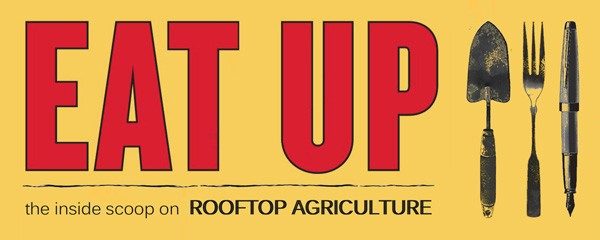the inside scoop with Lara Mrosovsky
A 6,500 square foot rooftop garden atop Toronto’s Access Alliance provides the community health center’s visitors with opportunities for community development, environmental education, and social health activities. Lara Mrosovsky, the organization’s Green Access Community Animator, engages primarily immigrants and refugees through the cultivation of over 40 heirloom vegetable varieties, over 40 medicinal and culinary herb varieties, and native ornamental plants, in less than 8-inches of soil!
1| What is the greatest obstacle your rooftop garden has overcome?
We have overcome a shallow soil depth of less than 8-inches and limited options for vertical growing. We have constructed low, stable tripods as supports for vining plants, placed climbing beans and cucumbers around the perimeter where they can climb the railing, and chosen bush varieties where possible. We have approached the shallow soil depth with top dressing and an effort to use organic soil amendments such as compost, insect frass, kelp meal and greensand. Consistent watering is possible with a drip irrigation system.
…We are the first Community Health Centre in Ontario to have an intensive green roof. A number of health services and programs for newcomers and refugees take place on a daily basis in our building, the AccessPoint on Danforth. Some programs are led by staff off Access Alliance, others by staff of four partner agencies in the building. The opportunity and challenge is for Green Access staff to shine a light on the garden and facilitate use of gardens and fresh food to strengthen the health outcomes of our programs and partner programs. Slowly but surely, more people in the building are becoming aware of the garden and its potential as a teaching space and place to promote health, environmental stewardship and healthy eating. As these connections are made and the Green Access program builds a portfolio of garden and food activities that are integrated into the Community Health Centre, our next challenge will be to showcase and demonstrate these [activities] across the health sector.
2| What piece of advice would you offer to aspiring skyline growers?
Choose your plants wisely, keep it diverse, and keep trying. At the outset of growing food in a soil depth of less than 8 inches with full sun we made some choices about which plants we expected to do better. For vegetables this included chili peppers, bush-type tomatoes, okra, beans, tomatillos, and ground cherries. The bush-type tomatoes are more manageable than vining ones in windy conditions, [not to mention that] vertical staking is more challenging in shallow soil. Some plants you wouldn’t expect to need staking on the ground, like compact chili pepper plants, do benefit when staked on the green roof as they are exposed to high winds, even on the second floor roof. Production of vegetables like tomatoes is assisted by mulching, consistent watering, and a generous top dressing of composted duck manure.
We avoided root crops such as potatoes, beets and carrots, and large, heavy feeders such as squash, pumpkin and watermelon. Needless to say, some self-seeded butternut squash showed us that squash could produce, albeit in limited quantities, and some youth insisted on seeding carrots, which grew reasonably well.
In the first year we tried seeding some salad greens thinking that as small, short-season food plants they would be suitable and productive – however the full sun and harsh heat soon proved too much stress and we witnessed baby greens speed up their life cycle, bolt when still tiny and produce limited leaf growth. So while lettuces, some types of spinach, bok choy, and mustard don’t yield a lot of leaf in these high-heat conditions, they do provide a bit more of a leaf harvest in earlier spring, later in fall, and when located in whatever shaded places we can find on the roof (like underneath the passive solar water collector). Also we leave space for heat-loving greens such as amaranth and callaloo, lambsquarters, molokhiya, arugula, fenugreek, and Malabar spinach. In terms of herbs, the best performers have been dry-loving and hardy herbs like thyme, lavender, mint, yarrow and chives, to name a few!
“Keep trying” because weather conditions vary from year to year, and micro-climates change from place to place, even within the same garden… “Keep it diverse” by experimenting with variety and biodiversity. The more different plants you try growing, the more likely you are to find those green roof winners that produce well year after year.
 EAT UP
EAT UP

Hello, my name is Pablo Jaramillo i’m an old friend of Lara. I’m from Chile and haven’t have any news from her since many years. Please tell her my email so we can be in contact again… Regards